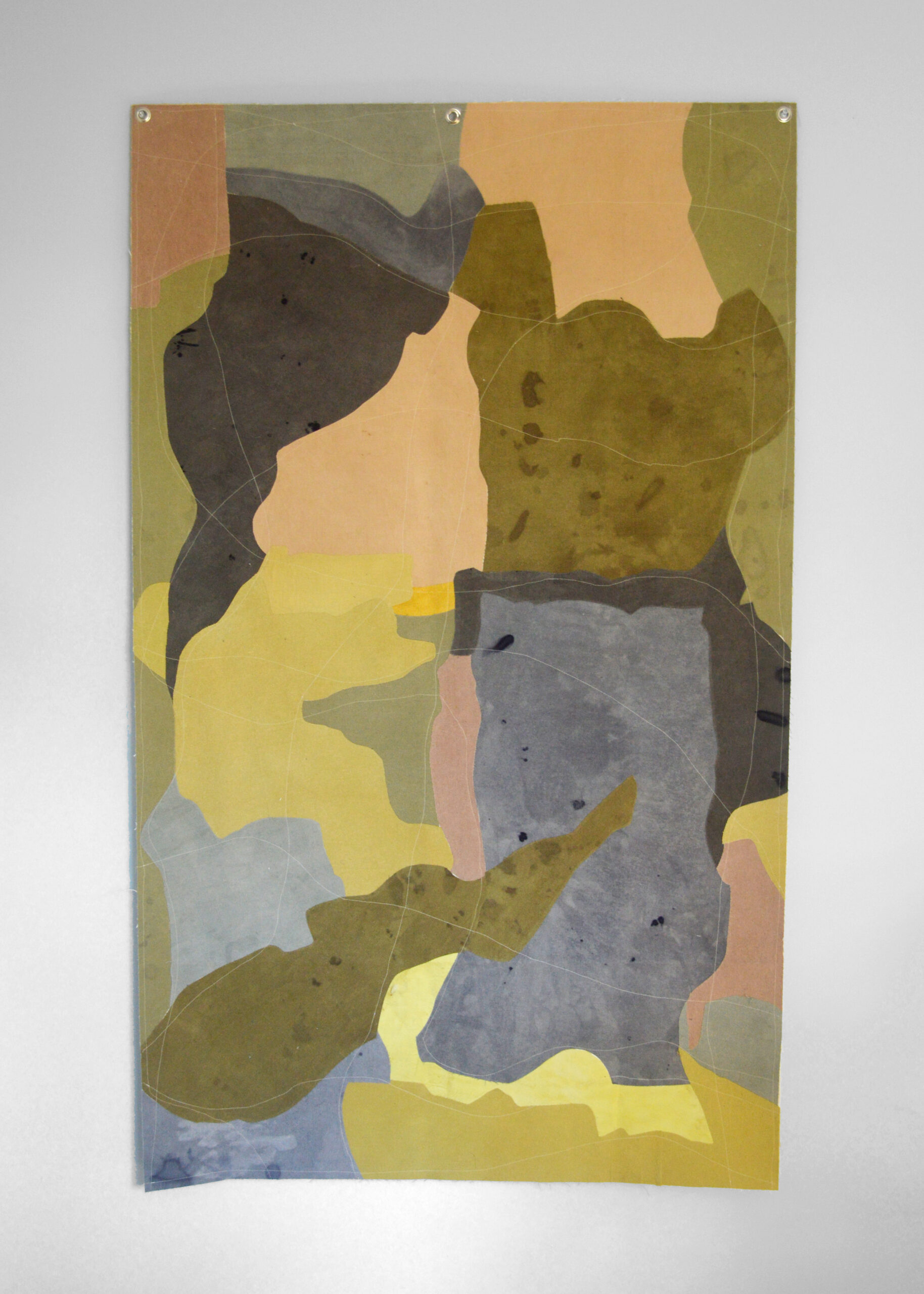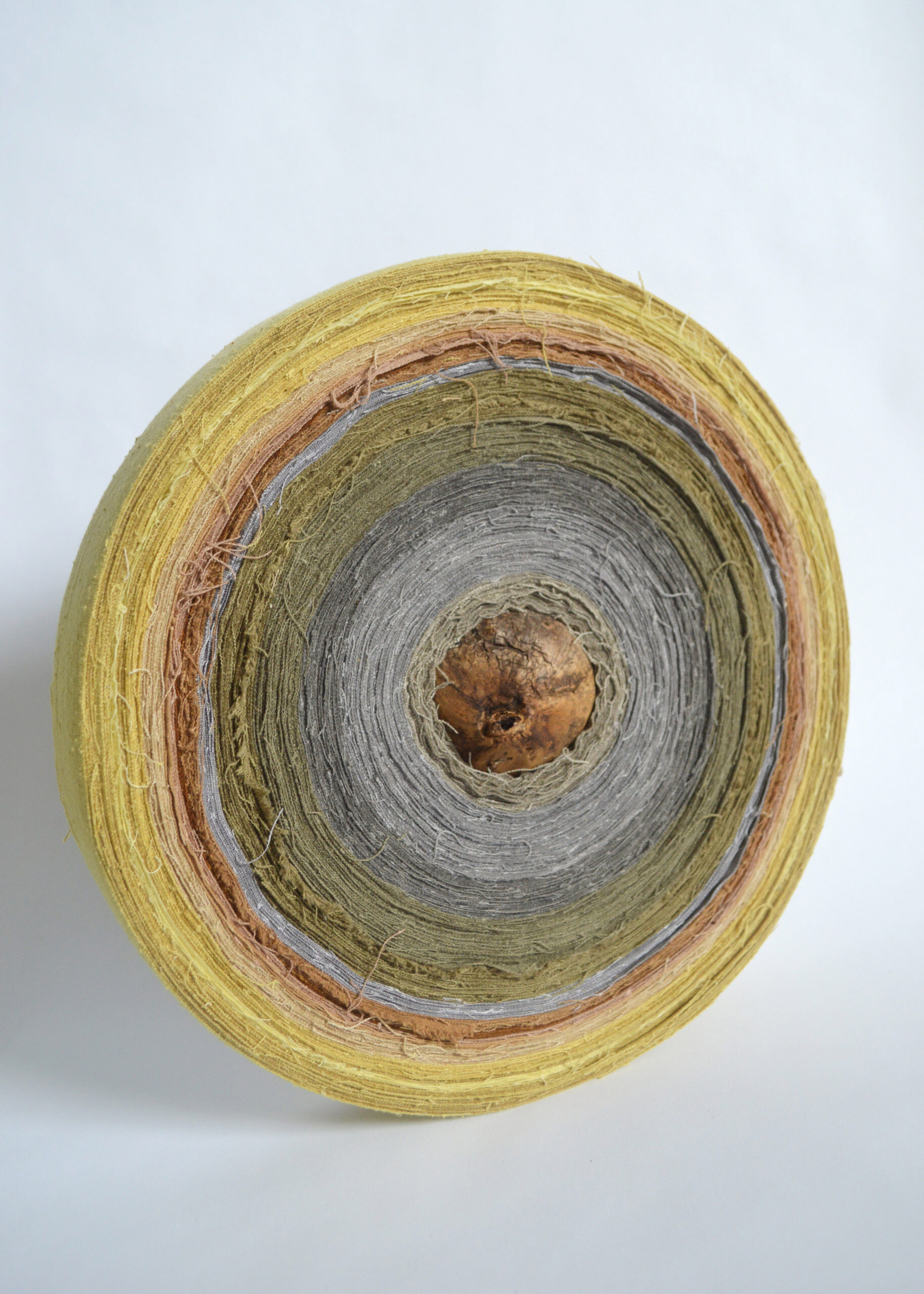Sofia Gonzalez
Portrait of Place (Self Portrait), 2014-Present
pomegranate, black bean, oak galls, rosemary, orange peel, mint leaves, oxalis (sour grass), fennel, blackberry leaves, eucalyptus, walnut, golden rod and sumac natural dye with iron and alum on raw silk 63 inches (H) x 12 inches (W) x 6 inches (D)
Portrait of Place (Self Portrait) is an ongoing sculpture, constantly growing to include the many plants and places I inhabit. It is an enduring process of accumulating layers and memories tied to the places I have lived and those I have yet to meet. The silk is dyed with plants and vegetables foraged in the places I have lived so far, including: San Rafael, CA, San Francisco, CA, Little Rock, AR, San Diego, CA, and Petaluma, CA. The sculpture is installed at my height to represent the many colors and places that have shaped me.
Sofia Gonzalez
Petaluma Map Flag, #1 (Flag of Petaluma Paths Taken in 2022), 2023
redwood cone, eucalyptus, pomegranate, oak gall, marigold, oxalis, and lavender dye on silk sewn to canvas 58 x 35 inches
Historically used to express pride, ownership, and land marking, I use the flag form to communicate kinship with the new land I now inhabit, the city of Petaluma in Sonoma County. Rather than a traditional marker of claim, the flag becomes a tool to visualize belonging, to question who belongs and how one belongs. The shapes within these flags are informed by walking and running through Petaluma since moving in July of 2022. By tracking my routes digitally, I draw repetitive lines with my body in space. Imposing my walk/run/drawn paths onto the Google Maps invention of what Petaluma land looks like from above, I input my own lines into this existing pattern. While digital tracking can start the attempt to locate me, my own memory of each walk/run fills in the rest. The resulting map will not be able to reliably get you from point A to point B in the shortest time with the most minimal traffic. It will not look to you like Petaluma, like your Petaluma. But it is my experience of Petaluma from July 2022 to January 2023. The colors of the flag are created from elements found along the paths I walk. Oak galls, mushrooms, pomegranates, redwood cones, oxalis flowers, rainwater, leaves, and barks: shared with the birds and respectfully collected. Each dye plant is foraged at the end of its days: the dead man’s foot mushroom sneaking through the crack in the cement at the culmination of its season; the oak galls after hosting their wasps and blowing to the ground; the redwood cones spreading new seed in the winter. Each walk/run is a stake at creating place, a chance to participate with the land I live on. 6 months. 383 miles. When do I become local?
Sofia Gonzalez
Invasive Attempt #11, 2023
oak gall wrapped in oak gall, pomegranate and dead man's foot mushroom dyed silk and cotton 10 x 10 x 2.5 inches
Inspired by the parasitic, yet symbiotic relationship between oak apple wasps and oak trees, Invasive Attempts consider potential reciprocal relationships with and within landscape. Gall wasps rely on oak trees, their host plant, for survival. By inducing galls on the branches of oak trees, gall wasps lay eggs and support growth through early stages of life. While the gall wasp uses the oak tree for its own gain, it is believed that very little harm occurs to the tree. What is left after the wasps have matured and taken flight are oak galls: round, porous balls that dry and fall to the ground after the wasps no longer need them. I collect fallen oak galls to use as a natural dye source, as well as a form for inspiration. Oak galls are both native to our landscape and a result of a parasitic reaction. Using silk dyed by neighboring plants, both local and invasive, I repeatedly wrap oak galls. Wrapping becomes a ritualistic act that quells anxiety while suffocating the gall in a protective hug.


